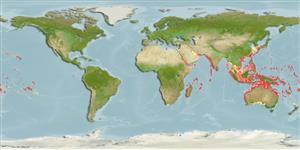Common names from other countries
Environment: milieu / climate zone / depth range / distribution range
Écologie
marin récifal; non migrateur; profondeur 0 - 60 m (Ref. 89972). Tropical; 30°N - 20°S
Indo-Pacific: Red Sea and East Africa (extending to Mossel Bay, South Africa, Ref. 5372) to the Hawaiian, Marquesan, and Ducie islands, north to southern Japan, south to Lord Howe and Rapa islands.
Length at first maturity / Taille / Poids / Âge
Maturity: Lm 13.0 range ? - ? cm
Max length : 25.0 cm TL mâle / non sexé; (Ref. 129178)
Épines dorsales (Total) : 12 - 13; Rayons mous dorsaux (Total) : 22 - 25; Épines anales: 3; Rayons mous anaux: 19 - 21.
May be seen in a variety of habitats ranging from rich coral reefs (Ref. 58652) to weedy and rubble covered areas (Ref. 1602). Benthopelagic (Ref. 58302). Maybe found singly, in pairs, and in aggregations that roam over large distances in search of food. Feed mainly by tearing pieces from polychaetes, sea anemones, coral polyps, and algae (Ref. 1602). Oviparous (Ref. 205). Form pairs during breeding (Ref. 205). Minimum depth reported taken from Ref. 128797.
Life cycle and mating behavior
Maturities | Reproduction | Spawnings | Egg(s) | Fecundities | Larves
Distinct pairing (Ref. 205). Monogamous mating is observed as both obligate and social (Ref. 52884).
Allen, G.R., 1985. Butterfly and angelfishes of the world. Vol. 2. 3rd edit. in English. Mergus Publishers, Melle, Germany. (Ref. 4858)
Statut dans la liste rouge de l'IUCN (Ref. 130435)
CITES (Ref. 128078)
Not Evaluated
Menace pour l'homme
Reports of ciguatera poisoning (Ref. 130160)
Utilisations par l'homme
Pêcheries: intérêt commercial mineur; Aquarium: Commercial
Outils
Articles particuliers
Télécharger en XML
Sources Internet
Estimates based on models
Preferred temperature (Ref.
115969): 25.5 - 29, mean 28 (based on 922 cells).
Phylogenetic diversity index (Ref.
82804): PD
50 = 0.5000 [Uniqueness, from 0.5 = low to 2.0 = high].
Bayesian length-weight: a=0.02512 (0.01625 - 0.03883), b=2.98 (2.85 - 3.11), in cm Total Length, based on LWR estimates for this species & Genus-body shape (Ref.
93245).
Niveau trophique (Ref.
69278): 3.7 ±0.3 se; based on diet studies.
Résilience (Ref.
120179): Haut, temps minimum de doublement de population inférieur à 15 mois (K = 1.5;).
Fishing Vulnerability (Ref.
59153): Low vulnerability (23 of 100).
